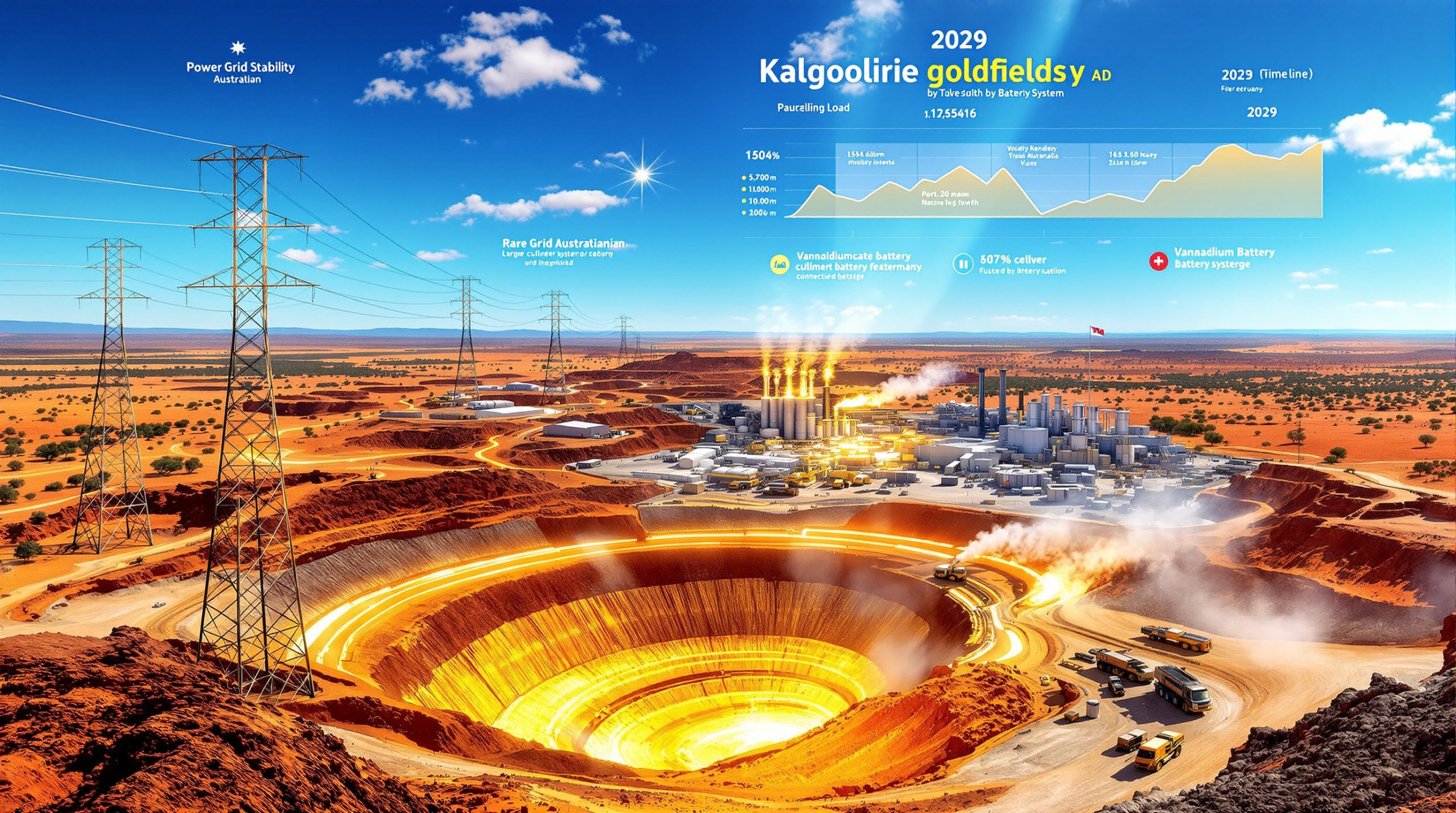The vanadium supply chain Kalgoorlie development represents a pivotal opportunity for Australia's energy storage sector, combining regional mining expertise with emerging battery technologies. This ambitious project encompasses domestic vanadium extraction, electrolyte manufacturing, and grid-scale battery deployment in Western Australia's Goldfields region. Furthermore, the initiative demonstrates how established mining infrastructure can be adapted for critical minerals transition applications in the renewable energy era.
Strategic Energy Infrastructure Scenarios in Australia's Mining Regions
Critical minerals development across Australia faces unprecedented momentum as renewable energy transitions accelerate globally. The intersection of mining heritage, technological innovation, and government policy creates unique opportunities for integrated supply chain development. Understanding these dynamics becomes essential for investors, policymakers, and industry participants navigating the evolving landscape of energy storage and critical minerals extraction.
Australia's position in global vanadium markets reflects broader trends in energy storage technology adoption. The growing recognition of vanadium flow batteries for grid-scale applications stems from their distinctive operational characteristics compared to lithium-ion alternatives. In addition, these systems offer extended discharge durations, minimal capacity degradation over time, and modular expansion capabilities that align with utility-scale energy storage requirements.
Regional Advantages for Integrated Vanadium Operations
Western Australia's Goldfields region possesses several foundational advantages that support vanadium supply chain integration. The area's established mining infrastructure, developed over more than a century of gold extraction, provides existing transportation networks, skilled workforce pools, and industrial support systems that can be adapted for vanadium operations.
The proximity to vanadium-bearing magnetite deposits creates logistical efficiency for raw material sourcing. Existing rail and road infrastructure, originally constructed to support gold mining activities, offers established pathways for material transportation. Consequently, this infrastructure foundation reduces capital requirements for new vanadium operations compared to greenfield development in remote locations.
Key Infrastructure Elements:
- Established rail connections linking mining areas to processing facilities
- Road networks capable of handling heavy equipment and material transport
- Power transmission infrastructure supporting industrial operations
- Water supply systems adapted from existing mining operations
- Maintenance and service facilities with mining equipment expertise
The regional workforce brings transferable technical skills from gold mining operations. Metallurgical processing experience, heavy equipment operation, and industrial maintenance capabilities provide a foundation for vanadium extraction and processing activities. However, this reduces training requirements and project implementation timelines compared to regions without established mining expertise.
Large-Scale Battery Systems and Grid Integration
The planned 50-megawatt, 500-megawatt-hour vanadium flow battery system represents significant infrastructure development for Australia's energy storage sector. This scale of deployment, described by government officials as the largest vanadium battery installation in the country, demonstrates commitment to long-duration storage technology integration. Moreover, this aligns with the broader mining industry evolution towards sustainable technology applications.
Technical Specifications and Capabilities:
| Parameter | Specification | Operational Significance |
|---|---|---|
| Power Output | 50 MW | Peak discharge capacity |
| Energy Storage | 500 MWh | Total energy capacity |
| Discharge Duration | 10 hours | Extended operation capability |
| System Type | Vanadium flow battery | Chemical energy storage |
| Scalability | Modular expansion | Future capacity increases |
The 10-hour discharge capability positions this system for applications requiring extended energy delivery periods. Unlike lithium-ion batteries typically designed for 1-4 hour discharge durations, vanadium flow batteries excel in applications requiring sustained power output over longer timeframes. This makes them particularly suitable for renewable energy firming and grid stabilisation services.
Vanadium flow batteries maintain consistent performance across thousands of charge-discharge cycles without significant capacity degradation. The electrolyte-based energy storage mechanism separates power generation from energy storage capacity, enabling independent optimisation of each system component. Furthermore, this design flexibility supports long-term operational reliability and cost-effectiveness.
Grid integration benefits include frequency regulation, peak load management, and renewable energy smoothing. The system's ability to provide rapid response to grid demand fluctuations supports power quality maintenance in regions with variable renewable energy generation. These capabilities become increasingly valuable as wind and solar generation penetration increases across Australia's electricity networks.
Vanadium Supply Chain Development Components
Establishing a localised vanadium supply chain involves multiple integrated stages, each requiring specific technical capabilities and infrastructure development. The complexity of this integration represents both opportunity and challenge for regional economic development, particularly when considering modern mine planning approaches.
Raw Material Extraction and Processing
Vanadium extraction typically begins with magnetite ore processing, where vanadium-bearing minerals are concentrated through magnetic separation techniques. Current Western Australian operations face reactivation challenges, including infrastructure rehabilitation and market development requirements. Additionally, successful operations like the green iron project demonstrate the potential for sustainable mineral processing.
The processing sequence involves several technically demanding stages:
- Ore crushing and magnetic separation to concentrate vanadium minerals
- Roasting operations to convert vanadium compounds into soluble forms
- Leaching processes to extract vanadium into solution
- Purification through solvent extraction and precipitation
- Final electrolyte preparation with precise chemical specifications
Each stage requires specialised equipment, technical expertise, and environmental compliance measures. The transition from raw ore to battery-grade electrolyte represents significant value addition but demands substantial capital investment and operational expertise.
Electrolyte Manufacturing and Quality Control
Battery-grade vanadium electrolyte production represents the most technically complex component of the supply chain. The process demands precise chemical balancing, contamination control, and quality assurance protocols to ensure consistent battery performance.
Manufacturing specifications include:
- Vanadium concentration levels meeting battery system requirements
- Impurity control to prevent performance degradation
- pH balancing for optimal electrochemical characteristics
- Stability testing under various operating conditions
- Quality certification for end-user applications
The modular nature of vanadium flow battery systems enables staged deployment approaches. Initial installations can begin operations while additional capacity is developed through electrolyte tank expansion rather than complete system replacement. Consequently, this scalability advantage supports phased investment strategies and demand-responsive capacity growth.
Policy Framework and Government Support Mechanisms
The Western Australian Government's commitment includes $150 million in funding support for the vanadium battery installation project. This financial backing addresses high capital requirements associated with establishing integrated vanadium operations and demonstrates policy commitment to critical minerals development. According to the WA Government announcement, this represents Australia's largest vanadium flow battery installation.
Government Support Elements:
Policy measures extend beyond direct financial support to include regulatory streamlining and fiscal incentives. The Expression of Interest process, operating until January 30, 2026, aims to identify existing market capabilities and evaluate detailed business cases from potential project partners. This procurement approach enables competitive selection while ensuring technical capability assessment.
"A locally made and sourced vanadium flow battery will create jobs during construction, deliver improved energy resilience for the region and complement other planned upgrades in the Goldfields region."
The policy framework emphasises local content requirements, encouraging domestic value addition throughout the supply chain. This approach supports regional economic development while building technical capabilities within Australia's critical minerals sector. However, investors must remain vigilant about investment risk flags when evaluating project opportunities.
Regulatory and Timeline Considerations
The two-stage Expression of Interest process includes:
- Stage 1: Market capability assessment (until January 30, 2026)
- Stage 2: Detailed business case evaluation (early-to-mid 2026)
This timeline enables systematic evaluation of technical proposals while maintaining project momentum. The structured approach balances thorough assessment requirements with deployment urgency driven by energy storage market demand.
Environmental approval processes, permitting requirements, and regulatory compliance measures represent critical path elements for project implementation. Government support includes coordination across regulatory agencies to streamline approval processes and reduce administrative delays.
Economic Impact Assessment and Employment Generation
The vanadium supply chain Kalgoorlie development creates multiple categories of economic activity, ranging from direct employment in mining and manufacturing to indirect effects through service provision and regional spending multipliers.
Direct Employment Projections:
| Employment Category | Estimated Jobs | Duration | Skill Requirements |
|---|---|---|---|
| Construction Phase | 200-300 | 2-3 years | Mixed technical/trade |
| Operations | 150 | Ongoing | Technical/professional |
| Support Services | 100-150 | Ongoing | Various levels |
Construction employment encompasses site preparation, equipment installation, and system commissioning activities. These positions typically require trade skills, equipment operation capabilities, and project management expertise. Furthermore, the temporary nature of construction employment necessitates workforce transition planning as projects move into operational phases.
Operational employment focuses on technical and professional positions including:
- Process operators for vanadium extraction and electrolyte production
- Maintenance technicians for specialised equipment systems
- Quality control analysts ensuring product specifications
- Safety and environmental compliance personnel
- Management and administrative support functions
Indirect Economic Effects
Beyond direct employment, vanadium supply chain development generates indirect economic activity through equipment procurement, service contracting, and regional spending effects. Local suppliers benefit from increased demand for maintenance services, transportation, accommodation, and business support functions.
Research and development partnerships with universities and technical institutions create knowledge transfer opportunities. Skills development programmes enhance regional capabilities in specialised areas including metallurgy, electrochemistry, and advanced manufacturing techniques. These educational investments support long-term economic diversification beyond individual project lifespans.
Global Market Positioning and Competitive Dynamics
Australia's entry into integrated vanadium supply chain development occurs within evolving global market conditions. International demand for long-duration energy storage grows as renewable energy deployment accelerates across major economies. Understanding these market dynamics helps assess commercial viability and strategic positioning opportunities.
Competitive Advantages:
Australia's competitive positioning includes several key factors:
- Resource Security: Domestic vanadium deposits reduce import dependency
- Technical Expertise: Established mining and metallurgical capabilities
- Regulatory Stability: Consistent policy framework supporting long-term investment
- Geographic Position: Strategic access to Asia-Pacific growth markets
Global vanadium supply chains currently concentrate in China, which dominates both mining and processing activities. Diversification of supply sources becomes strategically important for countries seeking to reduce dependency on single-source suppliers. Consequently, Australia's development of domestic capabilities addresses this diversification need while capturing value-addition opportunities.
Market Demand Drivers
Grid-scale energy storage applications favour vanadium flow batteries for discharge durations exceeding four hours. As renewable energy penetration increases across electricity networks, demand for long-duration storage systems grows correspondingly. Vanadium batteries complement shorter-duration lithium systems by providing extended energy delivery capabilities.
International markets including Japan, South Korea, and emerging economies across Southeast Asia represent potential export opportunities. These markets experience growing energy storage demand driven by renewable energy integration, grid modernisation, and energy security considerations. According to Australian Vanadium research, the global vanadium battery market is experiencing significant growth.
Risk Assessment and Mitigation Strategies
The vanadium supply chain Kalgoorlie development faces multiple risk categories requiring comprehensive mitigation strategies. Understanding these challenges enables proactive planning and contingency preparation across technical, commercial, and operational dimensions.
Technical and Operational Risks
Resource Development Challenges:
- Risk Factor: Delays in mine development and production ramp-up
- Mitigation Approach: Interim sourcing agreements with international suppliers
- Contingency Planning: Alternative supply sources during development phases
Technology Integration Issues:
- Risk Factor: Battery system performance below specifications
- Mitigation Approach: Partnerships with proven technology providers
- Quality Assurance: Comprehensive testing and validation protocols
Market and Commercial Risks
Vanadium price volatility affects project economics through both raw material costs and revenue projections. Historical price fluctuations reflect supply-demand imbalances, geopolitical factors, and steel industry demand variations. Long-term supply contracts and government policy support provide partial protection against market volatility impacts.
Strategic Risk Management Framework:
Successful supply chain development requires coordinated risk management across multiple stakeholders including government agencies, mining companies, technology providers, and end-users. Risk sharing mechanisms, insurance arrangements, and performance guarantees distribute project risks among parties best positioned to manage specific categories.
Government policy stability represents a foundational risk factor. Consistent regulatory frameworks, fiscal incentives, and procurement support enable long-term investment planning. Changes in political priorities or policy directions could significantly impact project viability and commercial attractiveness.
Implementation Timeline and Development Phases
The vanadium supply chain development follows a structured implementation approach spanning multiple years and distinct development phases. Understanding this timeline enables stakeholder coordination and investment planning across the integrated supply chain.
Phase 1: Planning and Approvals (2025-2026)
Current activities focus on Expression of Interest evaluation and partner selection processes. The January 30, 2026 deadline for Stage 1 submissions provides a definitive timeline for market capability assessment. Stage 2 evaluation in early-to-mid 2026 will assess detailed business cases and technical proposals.
Additional Phase 1 activities include:
- Environmental impact assessments for mining and processing operations
- Technology partner selection and partnership agreements
- Final investment decisions and financial arrangement confirmation
- Detailed engineering and procurement planning
Phase 2: Construction and Development (2026-2028)
Construction activities encompass mining infrastructure development, processing facility construction, and battery system installation. The parallel development of multiple supply chain components requires careful coordination to ensure synchronised completion and commissioning.
Key milestones include:
- Mining operations commencement and production ramp-up
- Processing facility construction and equipment commissioning
- Battery system installation and grid integration testing
- Operational readiness verification and performance validation
Phase 3: Operations and Expansion (2029+)
Commercial operations mark the transition from development to ongoing production and service delivery. Initial operational experience provides data for system optimisation and expansion planning. Market demand growth may support additional capacity development through modular system expansion.
Long-term success depends on operational performance, cost competitiveness, and market acceptance. Export market development could support larger-scale operations beyond domestic demand requirements. Technology improvements and cost reductions may enable expanded applications and market penetration.
Performance Monitoring and Success Metrics
Measuring the vanadium supply chain Kalgoorlie development success requires comprehensive performance indicators spanning technical, economic, and strategic objectives. These metrics enable progress tracking and identify areas requiring attention or adjustment.
Key Performance Indicators:
| Metric Category | Target | Measurement Frequency |
|---|---|---|
| Local Content | 70%+ | Quarterly |
| Employment Creation | 150+ ongoing positions | Annual |
| System Reliability | 95%+ availability | Continuous |
| Production Capacity | Target output levels | Monthly |
Technical Performance Measures
Battery system performance indicators include energy storage capacity utilisation, discharge duration achievement, and round-trip efficiency maintenance. Grid integration metrics assess frequency regulation capability, peak load management effectiveness, and renewable energy smoothing performance.
Supply chain reliability measures track production consistency, quality specifications compliance, and delivery schedule adherence. These operational metrics determine commercial viability and customer satisfaction across domestic and potential export markets.
Strategic Success Indicators
Beyond immediate project outcomes, success measurement includes technology transfer achievement, skills development progress, and regional economic development impacts. The project serves as a demonstration of Australia's critical minerals strategy implementation and positions the country for expanded participation in global energy storage markets.
Disclaimer: This analysis contains forward-looking statements and projections based on current policy announcements and market trends. Actual outcomes may vary significantly due to technical, commercial, regulatory, or market factors beyond current predictions. Investment decisions should consider comprehensive due diligence and professional advice appropriate to individual circumstances.
Are You Positioned to Capitalise on Australia's Critical Minerals Boom?
The vanadium supply chain development in Kalgoorlie exemplifies how Australia's critical minerals sector is creating unprecedented investment opportunities as the energy storage market accelerates globally. Discovery Alert's proprietary Discovery IQ model delivers real-time alerts on significant ASX mineral discoveries, instantly empowering subscribers to identify actionable opportunities ahead of the broader market and secure their competitive advantage with a 30-day free trial.




